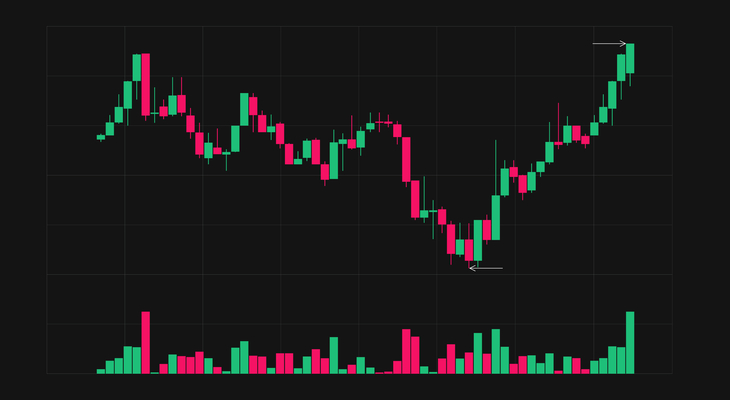According to a recent study, only 28% of individual investors beat the market over a 10-year period. This statistic highlights the importance of utilizing all available tools to make informed investment decisions. One such tool is stock ratings, which can provide valuable insights into the performance of a particular stock and its potential for future growth.
Among the various stock ratings, overweight rating is often seen as a strong indicator of a stock’s potential to outperform the market. In this article, we will explore the concept of overweight stock ratings and the implications they have for investors. We will examine the three-tier rating system and explain how overweight ratings differ from other ratings.
We will also discuss the importance of diversifying your investment portfolio and making informed investment decisions based on reliable data. Finally, we will provide tips for investors on how to use overweight stock ratings effectively and achieve long-term investment success. By understanding the power of overweight stock ratings, investors can unlock new opportunities and make sound investment decisions that lead to financial freedom.
Key Takeaways
- Overweight stock ratings suggest that a stock is expected to outperform a benchmark index and can be synonymous with a buy rating.
- Short-term trades and long-term investments have notable distinctions that can impact stock ratings and resulting investment decisions.
- Considering sector weights when building a portfolio ensures proper diversification and prevents overinvestment in a single sector.
- Stock ratings are a valuable tool for investors, but they should not be relied upon exclusively, and due diligence must be done to find the best stocks to buy.
Stock Ratings Basics
The basics of stock ratings are crucial for investors seeking to make informed investment decisions. Analysts typically use a three-tier or five-tier rating system to evaluate a company’s financial performance and provide buy, sell, or hold recommendations.
The most common weight rating system includes overweight, underweight, and equal weight ratings. An overweight rating suggests that a stock is expected to outperform a benchmark index, such as the SP 500. However, the absence of specific guidance in stock ratings can be attributed to the lack of standardized methods for analyzing analysts, making it essential for investors to understand analyst methodology.
Despite their usefulness, stock ratings have faced criticisms. The absence of specific guidance in stock ratings is a common criticism, as it does not provide investors with specific instructions on the quantity of stock to purchase. This can lead to confusion for investors, who must rely on their own understanding of the market and individual goals.
Furthermore, investors should know that rating systems can vary between rating firms, and the rating systems only provide a snapshot of a stock’s performance at a specific point in time. Therefore, it is crucial for investors to consider multiple criteria and opinions when making investment decisions.
The Three-Tier Rating System
Analysts evaluate a company’s financial performance using either a three-tier or a five-tier rating system, both of which provide guidance on a stock’s potential performance and help investors make informed decisions.
The three-tier rating system is the most commonly used and includes overweight, underweight, and equal weight ratings.
Here are some examples of overweight rated stocks and factors affecting overweight ratings.
-
Examples of overweight rated stocks: Some examples of overweight rated stocks include Amazon, Apple, and Facebook. These stocks are expected to perform better than their industry peers and the overall market.
-
Factors affecting overweight ratings: Analysts typically evaluate a company’s financial performance, including revenue growth, earnings, debt-to-equity ratio, and other financial metrics. Other factors that can affect overweight ratings include industry trends, global economic conditions, geopolitical events, and company-specific news and events.
It’s important for investors to diversify their portfolio and not rely solely on overweight rated stocks. Diversification can help mitigate risk and ensure a balanced portfolio.
- Limitations of overweight ratings: Overweight ratings are not a guarantee of future performance, and investors should conduct their own research and due diligence before making any investment decisions. Additionally, overweight ratings may not be suitable for all investors, as risk tolerance and investment goals vary from person to person.
Implications of Overweight Ratings
Investors should be aware of the potential impact of overweight ratings on their investment decisions. An overweight rating suggests that a stock is expected to outperform a benchmark index, such as the SP 500. This rating is considered a positive signal, indicating that the stock has the potential for excellent long-term investment benefits. However, investors should also consider the risks of overweight ratings. The absence of specific guidance on the quantity of stock to purchase can lead to overinvestment, which can increase risk. Additionally, overweight ratings can quickly become outdated, and the rating system is only as good as its developers. Therefore, investors should do their due diligence to find the best stocks to buy, considering multiple criteria and opinions.
To further illustrate the potential impact of overweight ratings, we can look at the following table:
| Implications of Overweight Ratings | Emotional Response |
|---|---|
| Positive signal | Hopeful |
| Outperforming peers and broader market | Confident |
| Excellent long-term investment | Excited |
| Lack of specific guidance on quantity of stock to purchase | Uncertain |
As we can see, overweight ratings can evoke a range of emotions in investors, from hopeful to uncertain. While the positive signal of outperforming peers and the broader market can generate confidence and excitement, the lack of specific guidance on the quantity of stock to purchase can create uncertainty. Therefore, investors should consider all factors and do their research before making any investment decisions based on overweight ratings.
Investment Decisions and Portfolio Balance
Considering various factors such as price targets, timeframes, and portfolio balance is critical when making informed investment decisions.
Short-term trades typically rely on technical analysis and are considered more volatile and risky than long-term investments. Price targets provide guidance on the expected future price of a stock, while timeframes suggest how long it may take for a stock to reach its target. It is essential to consider both factors when making investment decisions, as they can impact the potential return on investment and the level of risk involved.
Portfolio balance is also crucial when making investment decisions. Diversification strategies involve having a mix of stocks and other financial assets in a portfolio to mitigate risk and ensure diversification. Considering sector weights when building a portfolio ensures proper diversification and prevents overinvestment in a single sector.
Risk assessment is essential when building a portfolio, and investors should consider both individual stock risk and systemic risk. By considering multiple criteria and opinions, investors can make better-informed decisions and ultimately achieve greater success in the complex world of investments.
Tips for Investors
To better navigate the complex world of investments, understanding the potential criticisms and considerations of stock ratings is crucial for informed decision-making. While stock ratings can be a valuable tool for investors, they should not be relied upon exclusively. Investors should consider multiple criteria and opinions before making any investment decisions. Additionally, due diligence must be done to find the best stocks to buy. Rating systems can vary between rating firms, and analyst ratings can quickly become outdated. Therefore, investors should use stock research tools to quickly check the current ratings and price targets of all published weight ratings.
Analyzing trends and evaluating risks is also crucial when making investment decisions. Investors should take into consideration the industry trends and movements in the market to make informed decisions. Diversifying a portfolio with a mix of stocks and other financial assets is also important to mitigate risk and ensure proper portfolio balance. Proper diversification requires considering sector weights to prevent overinvestment in a single sector. By following these tips and considering all relevant factors, investors can make better-informed decisions and ultimately achieve greater success in the complex world of investments.
| Tip | Description | |
|---|---|---|
| Use multiple criteria | Consider multiple criteria and opinions before making any investment decisions. | |
| Do due diligence | Due diligence must be done to find the best stocks to buy. | |
| Check current ratings | Use stock research tools to quickly check the current ratings and price targets of all published weight ratings. | |
| Analyze trends | Analyzing trends and movements in the market is crucial when making investment decisions. | |
| Diversify portfolio | Diversify a portfolio with a mix of stocks and other financial assets to mitigate risk and ensure proper portfolio balance. | … This can also include diversifying across industries and sectors to further reduce risk and increase potential returns. |
Additional Information
The founder of daytradingz.com, with 20 years of experience in financial markets, aims to make trading and investing easy to understand and has been quoted on major publications including Benzinga, Business Insider, Newsweek, and investing.com.
As a result, daytradingz.com has become a trusted source for information on trade strategies and market trends. The website offers a range of resources, including educational materials, trading tools, and market analysis, to help investors make informed decisions.
One of the key features of daytradingz.com is its focus on momentum stocks, which are stocks that are exhibiting strong upward or downward trends. The website provides guidance on how to identify and trade these stocks, as well as tips on how to manage risk and maximize returns.
In addition, daytradingz.com offers insights into market trends and provides analysis on the factors driving these trends. Whether you are a novice investor or an experienced trader, daytradingz.com can help you unlock the power of overweight stock ratings and achieve greater success in the complex world of investments.
Frequently Asked Questions
How can investors determine the quantity of stock to purchase when an overweight rating is provided?
When an overweight rating is provided, investors may wonder how to determine the quantity of stock to purchase. While the rating suggests that the stock is expected to outperform a benchmark index, it does not provide specific guidance on the amount of stock to buy.
Investor psychology and risk management are critical factors to consider when making investment decisions. Investors should assess their risk tolerance and financial goals before deciding on the quantity of stock to purchase. Diversification is also essential to mitigate risk, and investors should consider sector weights when building a portfolio.
Ultimately, investors should conduct due diligence and consider multiple criteria and opinions to make better-informed decisions.
What are some potential criticisms of stock ratings that investors should be aware of?
What are some potential criticisms of stock ratings that investors should be aware of?
Alternative strategies and historical accuracy are two potential criticisms of stock ratings that investors should consider. While stock ratings can provide valuable guidance on a company’s financial performance, they are not foolproof.
For instance, ratings may not account for alternative strategies that a company may take in the future, such as expanding into new markets or changing its business model. Additionally, historical accuracy is not always a guarantee, as analysts may not always correctly predict market trends or company performance.
It is important for investors to consider multiple sources of information and conduct their due diligence to make informed investment decisions.
How do short-term trades differ from long-term investments and how can this impact stock ratings and investment decisions?
Short-term trades differ from long-term investments in various ways, which can have an impact on stock ratings and investment decisions. Short-term trades rely heavily on technical analysis and are considered more risky and volatile than long-term investments.
As such, stock ratings may differ between the two types of investments, with overweight ratings being more applicable to long-term investments that have a positive outlook.
Risk management is also a critical consideration when investing in overweight stocks, as overinvestment in a single sector can pose significant risks to a portfolio. Therefore, investors must maintain a diversified portfolio that includes a mix of stocks and other financial assets to mitigate risk and ensure proper diversification.
Ultimately, investors must consider multiple criteria and opinions to make better-informed decisions and achieve greater success in the complex world of investments.
How can investors ensure proper diversification in their portfolio and prevent overinvestment in a single sector?
To ensure proper diversification in a portfolio, investors need to consider sector concentration when selecting stocks. Portfolio diversification means having a mix of assets that mitigates risk and ensures that no single asset or sector dominates the portfolio.
Sector concentration occurs when a significant portion of the portfolio is invested in a single industry or sector, which makes the portfolio vulnerable to market trends and fluctuations in that sector.
Investors can avoid sector concentration by investing in a diverse mix of stocks from different sectors, or by investing in exchange-traded funds (ETFs) that track a broad market index. By doing so, investors can ensure that their portfolio is well-diversified and not overly dependent on any single sector or industry.
What are some limitations of relying solely on stock ratings for investment decisions and how can investors overcome these limitations?
Limitations of relying solely on stock ratings for investment decisions include the lack of standardized methods for analyzing analysts, potential biases, and the possibility of outdated information.
To overcome these limitations, investors should consider multiple criteria and opinions, conduct their due diligence, and not rely solely on stock ratings. Mitigation strategies include using stock research tools to quickly check the current ratings and price targets of all rating firms that published their weight ratings, and considering timeframes and portfolio balance when making investment decisions.
It is important to recognize that stock ratings are only one tool in the complex world of investments, and investors should approach them with caution, doing their own research, and considering multiple sources of information before making any investment decisions.
Conclusion
In conclusion, overweight stock ratings can be a valuable tool for investors seeking long-term success in the stock market. These ratings suggest that a stock is expected to outperform the benchmark index and can be seen as a buy recommendation.
However, it is important to understand the implications of these ratings and use them in conjunction with other factors such as industry trends and company fundamentals.
Investors should also take a balanced approach to their portfolios and not rely solely on overweight ratings. Diversification and risk management are key components of a successful investment strategy.
As with any investment decision, it is important to do thorough research and consult with a financial advisor before making any significant moves in the stock market.
Overall, understanding the power of overweight stock ratings and how to use them in conjunction with other factors can help investors achieve success in the complex world of investments. By taking a balanced and informed approach, investors can unlock the potential of these ratings and make informed decisions for their portfolios.











